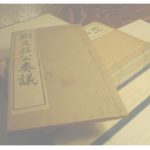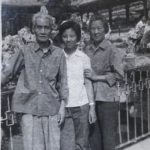My Yeye and Nainai, and the list kinship titles or filial terms:
爷爷 奶奶 – Yeye and Nainai:- paternal grandfather/mother
公公 婆婆 (外公,外婆) – Gonggong and Popo (Waigong, Waipo): maternal grandfather/mother
七世祖 Great-Great-Great-great grandfather
六世祖 Great-Great-great grandfather
高祖父 Great-great grandfather
曾祖父 Great-grandfather
祖父 Grandfather
父 Father
你 YOU
子 Son
孙 Grandson
曾孙 Great-Grandson
玄孙 Great-Great-Grandson
六代孙 Great-Great-Great-Grandson
七代孙 Great-Great-Great-Great-Grandson 谦称为7世孙
There were five generations that each man hoped to be able to venerate – his parents, his grandparents, and the three generations preceding them.
舅舅 – Jiujiu: mother’s brother
小姨 (姨妈) – Xiaoyi (Yima): mother’s sister
伯父 – Bofu: father’s older brother
叔叔 – shu shu: father’s younger brother
姑姑 (姑妈) – Gugu (Guma): father’s sister
表哥 biaoge: older male cousin
表弟 biaodi: younger male cousin
表姐 biaojie: older female cousin
表妹 biaomei: younger female cousin
侄子 zhizi: brother’s son; nephew
侄女 zhinǚ brother’s daughter; niece
外甥 waisheng: sister’s son; nephew
外甥女 waishengnǚ: sister’s daughter; niece
女婿 nǚxu: son-in-law, daughter’s husband
媳妇 xifu: son’s wife; daughter-in-law
妯娌 zhouli: wives of brothers
嗣子 sizi: heir; descendant (adapted son could be a sizi)
嫡子 dizi: of or by the wife (as distinguished from a concubine under the feudal-patriarchal system); of lineal descent; closely related.
庶子 shuzi: by the concubine (as distinguished from the legal wife)
Although Chinese don’t have a specific name (pre-defined) like Jane and Joe, there are a few words that are indicative if used in a name, such as 伯, 仲, 叔, 季, 孟, etc. They refer to the sequence of siblings. People often use them in their courtesy name or pseudonym, rather than in their birth name.
The Christian name has it own confusing moments. Mainly from translation to English, for example, Warren Delano’s last name was shortened from de la Noye, which had been seen in the early records of New England as Dellanoe, Dellnoe, Dilnow, Dillno and Delanoy. The second one is suffix (Sr., Jr., III, IV, etc.) when the son takes his father’s name.
Before 1949, a learned person often had a wide array of names, ranging from a courtesy name taken on at the age of 20 to posthumous titles, because calling one by his or her birth name was considered impolite.

名 ming: the name one was born to
字 zi: courtesy name (or adult name; “字”限于有身份的人) taken at the age of 20, by which a person is sometimes called
官名 guanming: formal name / nom de plume
号 hao: pseudonym, an alternative courtesy name
晚号 wan hao: an assumed name or alternative name taken at older age
谥号 shihao: posthumous title, is given to honor one’s lifetime achievement by the reign emperor. i.e. 文庄公, 悫慎公.
Lyons F. Livingston had commented on Philatelist (January 1949 issue) that “no Chinese name can be transliterated exactly”, and he was right. For a non-Chinese speaker, spelling would still be a headache even after conquering the generation gap, unique titles, and assortment of names.

China was forced to open to the West after the Second Opium War or Arrow War (1856-1860). The translation of the Chinese names of people and locals from Chinese logograms to a syllabary language, such as English, began. At first, the Wade-Giles’ romanization system was used. Thomas Wade and Herbert A. Giles were British diplomats and sinologists. Their system was not as tight as the pinyin which is used nowadays. Over the century, a name (either of a person or place) would often gain many different spellings. For example, Zhou Xuexi (in pinyin; 周学熙) could be written as Chou Hsüeh-hsi or Chow Hsuehsi (Chow Hsen Hsih in French). I’ve seen Zhou 周 as a family name written as Chow, Chou, and Chong. The different spellings also come from various dialects. Zhang 张 is spelt Cheung in Hong Kong and Chang in Taiwan.
China has been rising on the world stage since its economic reform and pinyin transliteration became the standard. Am I missing anything? How about taking husband’s name? Hmmmmm … that’s the Western practice. Chinese women do NOT. After all, Chairman Mao had bestowed half the sky to my sisters.
______________________
2014 姓氏 and the 2nd part
 SFaBB
SFaBB
Be First to Comment